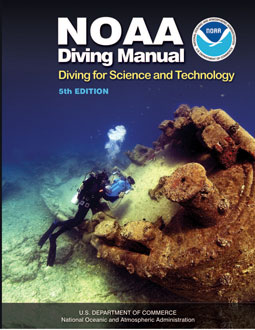Performing repetitive dives requires a the use of a dive plan. The diver must know what the no-stop dive time limits will be for the dives prior to descending so as not to incur additional decompression obligations. A planned dive schedule will work assuming the diver adheres to the maximum depth and time parameters defined before descending; however, this does not always occur. There are many reasons why divers may find themselves deeper than planned. Some of these might include: higher than normal tides while working on a specific site, down-welling currents, the need to descend deeper to pick up tools or experimental apparatus that may have been dropped, the unexpected need to provide assistance to divers who are working at deeper depths (either on a routine or emergency basis), or perhaps just plain inattention of the divers.
Likewise, there are many reasons that a diver may need to remain under water longer than anticipated. Some of these might include entrapment, entanglement, loss of navigational referencing, need to delay ascent due to hazardous marine life or other dangers like vessels passing overhead, need to deal with equipment issues before ascending, need to provide assistance to other divers (especially on an emergency basis), or again, inattention to time. Regardless of the cause of exceeding the constraints of a given dive plan, divers should have considered the impact of such occurrences, and how they should be dealt with, prior to beginning the dive. Typically, dive plans should include:
- Dive profiles for the planned dive
- The planned dive schedule plus 10 fsw (3.1 msw)
- The planned schedule plus 5–10 minutes (depending on conditions and team experience)
- The planned dive schedule plus both an increase in depth of 10 fsw (3.1 msw) and a time extension of 5–10 minutes.
These contingency plans should be discussed with all dive team members. It may be wise to write the planned dive schedule plus the contingency plans on slates prior to descent, so that if some event does impact the dive, team members are not trying to develop a procedure to deal with the incident while under water.
(Source: NOAA Diving Manual: Diving for Science and Technology, 5th Edition; 2013, Best Publishing Company)
SUGGESTED READING
|
|
NOAA Diving Manual, 5th Edition Used by divers everwhere, the NOAA Diving Manual 5th Edition is the most comprehensive resource for learning about dive equipment, dive planning, decompression, and emergency medical care of an injured diver. Chapters also include more advanced concepts such as physics and physiology, mixed gas diving, surface-supplied diving, saturation diving, and the list goes on. Need a textbook for your next course? Use this manual! The manual is the perfect resource for scientific divers, commercial, military, public safety, recreational divers, and dive leaders! |

